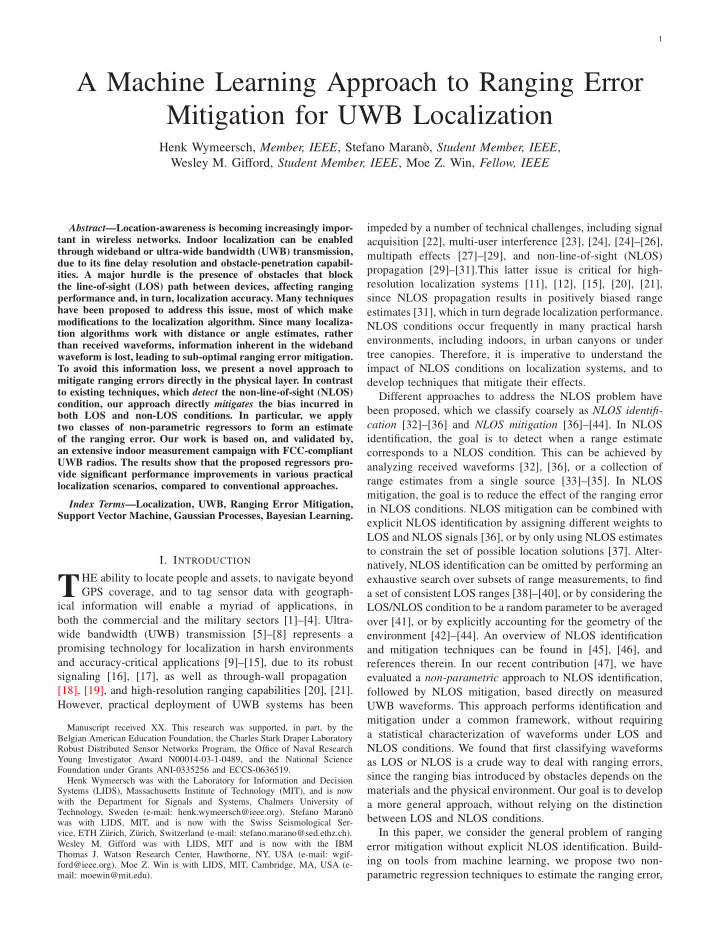



1 A Machine Learning Approach to Ranging Error Mitigation for UWB Localization Henk Wymeersch, Member, IEEE , Stefano Maranò, Student Member, IEEE , Wesley M. Gifford, Student Member, IEEE , Moe Z. Win, Fellow, IEEE Abstract —Location-awareness is becoming increasingly impor- impeded by a number of technical challenges, including signal tant in wireless networks. Indoor localization can be enabled acquisition [22], multi-user interference [23], [24], [24]–[26], through wideband or ultra-wide bandwidth (UWB) transmission, multipath effects [27]–[29], and non-line-of-sight (NLOS) due to its fine delay resolution and obstacle-penetration capabil- propagation [29]–[31].This latter issue is critical for high- ities. A major hurdle is the presence of obstacles that block resolution localization systems [11], [12], [15], [20], [21], the line-of-sight (LOS) path between devices, affecting ranging since NLOS propagation results in positively biased range performance and, in turn, localization accuracy. Many techniques have been proposed to address this issue, most of which make estimates [31], which in turn degrade localization performance. modifications to the localization algorithm. Since many localiza- NLOS conditions occur frequently in many practical harsh tion algorithms work with distance or angle estimates, rather environments, including indoors, in urban canyons or under than received waveforms, information inherent in the wideband tree canopies. Therefore, it is imperative to understand the waveform is lost, leading to sub-optimal ranging error mitigation. To avoid this information loss, we present a novel approach to impact of NLOS conditions on localization systems, and to mitigate ranging errors directly in the physical layer. In contrast develop techniques that mitigate their effects. to existing techniques, which detect the non-line-of-sight (NLOS) Different approaches to address the NLOS problem have condition, our approach directly mitigates the bias incurred in been proposed, which we classify coarsely as NLOS identifi- both LOS and non-LOS conditions. In particular, we apply cation [32]–[36] and NLOS mitigation [36]–[44]. In NLOS two classes of non-parametric regressors to form an estimate of the ranging error. Our work is based on, and validated by, identification, the goal is to detect when a range estimate an extensive indoor measurement campaign with FCC-compliant corresponds to a NLOS condition. This can be achieved by UWB radios. The results show that the proposed regressors pro- analyzing received waveforms [32], [36], or a collection of vide significant performance improvements in various practical range estimates from a single source [33]–[35]. In NLOS localization scenarios, compared to conventional approaches. mitigation, the goal is to reduce the effect of the ranging error Index Terms —Localization, UWB, Ranging Error Mitigation, in NLOS conditions. NLOS mitigation can be combined with Support Vector Machine, Gaussian Processes, Bayesian Learning. explicit NLOS identification by assigning different weights to LOS and NLOS signals [36], or by only using NLOS estimates to constrain the set of possible location solutions [37]. Alter- I. I NTRODUCTION natively, NLOS identification can be omitted by performing an T HE ability to locate people and assets, to navigate beyond exhaustive search over subsets of range measurements, to find GPS coverage, and to tag sensor data with geograph- a set of consistent LOS ranges [38]–[40], or by considering the ical information will enable a myriad of applications, in LOS/NLOS condition to be a random parameter to be averaged both the commercial and the military sectors [1]–[4]. Ultra- over [41], or by explicitly accounting for the geometry of the wide bandwidth (UWB) transmission [5]–[8] represents a environment [42]–[44]. An overview of NLOS identification promising technology for localization in harsh environments and mitigation techniques can be found in [45], [46], and and accuracy-critical applications [9]–[15], due to its robust references therein. In our recent contribution [47], we have signaling [16], [17], as well as through-wall propagation evaluated a non-parametric approach to NLOS identification, [18], [19], and high-resolution ranging capabilities [20], [21]. followed by NLOS mitigation, based directly on measured However, practical deployment of UWB systems has been UWB waveforms. This approach performs identification and mitigation under a common framework, without requiring Manuscript received XX. This research was supported, in part, by the a statistical characterization of waveforms under LOS and Belgian American Education Foundation, the Charles Stark Draper Laboratory NLOS conditions. We found that first classifying waveforms Robust Distributed Sensor Networks Program, the Office of Naval Research Young Investigator Award N00014-03-1-0489, and the National Science as LOS or NLOS is a crude way to deal with ranging errors, Foundation under Grants ANI-0335256 and ECCS-0636519. since the ranging bias introduced by obstacles depends on the Henk Wymeersch was with the Laboratory for Information and Decision materials and the physical environment. Our goal is to develop Systems (LIDS), Massachusetts Institute of Technology (MIT), and is now with the Department for Signals and Systems, Chalmers University of a more general approach, without relying on the distinction Technology, Sweden (e-mail: henk.wymeersch@ieee.org). Stefano Maranò between LOS and NLOS conditions. was with LIDS, MIT, and is now with the Swiss Seismological Ser- In this paper, we consider the general problem of ranging vice, ETH Zürich, Zürich, Switzerland (e-mail: stefano.marano@sed.ethz.ch). Wesley M. Gifford was with LIDS, MIT and is now with the IBM error mitigation without explicit NLOS identification. Build- Thomas J. Watson Research Center, Hawthorne, NY, USA (e-mail: wgif- ing on tools from machine learning, we propose two non- ford@ieee.org). Moe Z. Win is with LIDS, MIT, Cambridge, MA, USA (e- parametric regression techniques to estimate the ranging error, mail: moewin@mit.edu).
Recommend
More recommend